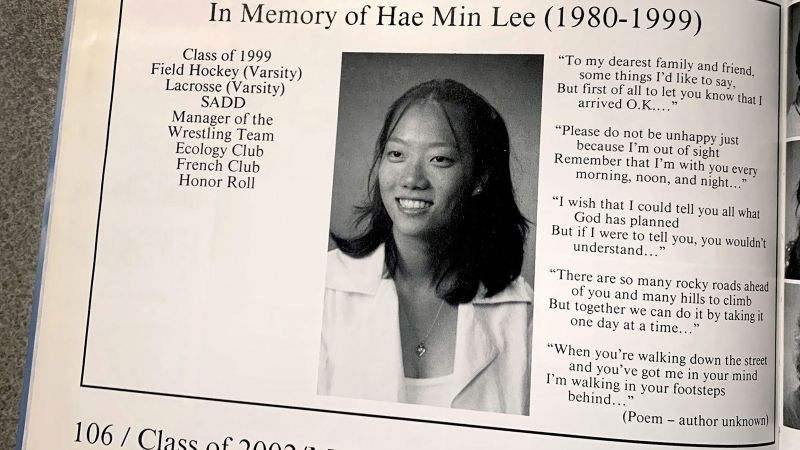Crime scene photos can evoke a visceral reaction, and the images surrounding the case of Hae Min Lee are no exception. They become indelible marks on the collective consciousness, serving not just as visual evidence, but as poignant reminders of unspeakable tragedy. Even years after the events transpired, the photographs continue to evoke shock and contemplation. This article delves into the reasons these images retain their unsettling potency, exploring themes of memory, morality, and the enduring impact of violence.
First, it is essential to acknowledge the human cost embedded within these images. Hae Min Lee was not merely a statistic or a nameless victim; she was a vibrant young woman with dreams, aspirations, and a life yet to be lived. The crime scene photos starkly juxtapose the vitality she embodied against the grim realities of her untimely death. This inherent contrast is a psychological catalyst, compelling viewers to confront their discomfort. The very act of viewing such imagery can provoke a profound emotional response, revealing the delicate interplay between life and death.
Further compounding this emotional resonance is the age-old fascination with crime and mortality that has permeated human culture. From ancient literature to contemporary media, stories of tragic figures and their demise captivate audiences. The images associated with Hae Min Lee assure that the narrative surrounding her case is not merely a distant tale, but an ongoing discourse that invites reflection and discussion about justice, fairness, and societal values. The enigmatic nature of her death continues to fuel a societal intrigue, creating an environment ripe for both sensationalism and solemn contemplation.
Moreover, the contentious nature of the investigation and its aftermath keeps these images relevant. Hae’s case has undergone meticulous scrutiny, sparking debates surrounding the efficacy of the criminal justice system, as well as the question of wrongful conviction. The persistent public interest often leads to dialogues questioning the ethics of showcasing such images. Some argue that displaying crime scene photos serves as a necessary historical record, while others advocate for the dignity of the deceased, emphasizing the imperative to handle such representations with care.
A vital aspect of this debate hinges on the notion of voyeurism. The human tendency to peer into the morbid aspects of life can blur ethical boundaries. The phenomenon of true crime fandom illustrates this point, with countless individuals consuming real-life tragedies for entertainment. The photos associated with Hae Min Lee illuminate societal insecurity about this voyeuristic impulse. They challenge us to discern our motivations: Are we seeking knowledge and understanding, or are we drawn to the spectacle of suffering?
As we confront these images, they evoke questions about accountability and the nature of justice. Hae’s case is tangled in layers of complexity, from the questions surrounding her relationship with her ex-boyfriend to the broader implications of how her story has been portrayed in media outlets. The image serves as a stark reminder of the individual transcendence affected by systemic failures. Each photograph offers a silent testimony to a life lost, urging us to consider the systemic and individual failures that contribute to such tragedies.
The generational divide in the analysis of Hae Min Lee’s photographs is also noteworthy. For those who lived through the timeline of events during the late 1990s, the images evoke a vivid recollection of a tumultuous era rife with unanswered questions. Alternatively, younger audiences might view them through a modern lens dominated by social media, where the rapid flow of information often drowns out the personal narratives that these images embody. Each generation brings its own context, contributing to a continually evolving discourse that engages with the implications of crime scene imagery.
Furthermore, the preservation and public scrutiny of these photographs prompt discussions about respect for victims and their families. Hae Min Lee’s family continues to grapple with the ramifications of her loss. The ongoing legal proceedings and the relentless media coverage act as a stark reminder of the personal realities behind the sensationalized narratives. As such, pictures depicting her tragic demise challenge the public to consider the human stories overshadowed by the pursuit of spectacle.
The psychological effects of observing crime scene photos warrant further discussion. The phenomenon of “crime scene voyeurism” can produce not only shock but also desensitization. Viewing such images repeatedly may lead to a numbing effect, dulling the emotional responses of individuals over time. This raises critical questions about society’s relationship with violence and its ramifications. Are these images stirring genuine empathy, or are they becoming mere fleeting distractions in an increasingly desensitized culture?
Ultimately, crime scene photos of Hae Min Lee serve as complex artifacts that speak volumes about society’s collective psyche. They force us to confront uncomfortable truths about mortality, justice, and human nature. The shock that these images incite is not merely an initial jolt; rather, it is an ongoing dialogue that demands engagement with deeper ethical and philosophical questions. Each viewer encounters these images through their unique lens, challenged to reflect, question, and ultimately understand the weight of the stories they tell. In an era characterized by infinite access to information and sensationalism, the enduring shock of these photographs persists, beckoning society to engage with the truths they reveal.

